College of Liberal Arts & Sciences
1N30.50 - Impulse Demo - Elastic and Inelastic Pendulum
Set the sad-happy ball combo on the suspension and move the suspension apart until the ball swings without any lateral movement. Set the upright meter stick to a position so that when you pull back on the pendulum you come to about 62 cm. To change from an elastic to an inelastic collision just reverse the bifilar supports. The inelastic collision will not knock over the board where as the elastic collision will.
- Rod Cross, "Elastic and Inelastic Collisions of a Ball with a Wood Block", TPT, Vol. 55, #8, Nov. 2017, p. 467.
- Paul Hewitt, "Answer to January 2017 Figuring Physics", TPT, Vol. 55, #2, Feb. 2017, p. 120.
- Paul Hewitt, "Answer to November 2016 Figuring Physics", TPT, Vol. 54, #9, Dec. 2016, p. 565.
- Xueli Zou, "The Sandbag Collision", TPT, Vol. 44, #7, Oct. 2006, p. 448.
- Paul G. Hewitt, "The Bouncing Dart", TPT, Vol. 22, #5, May 1984, p. 302, reprinted in TPT, Vol. 44, #6, Sept. 2006, p. 394.
- Edward P. Wyrembeck, "Using a Force Plate to Correct Student Misconceptions", TPT, Vol. 43, #6, Sept. 2005, p. 384.
- Willem H. van den Berg, "Force Exerted by a Falling Chain", TPT, Vol. 36, #1, Jan. 1998, p. 44.
- P. Roura, "Collision Duration in the Elastic Regime", TPT, Vol. 35, #7, Oct. 1997, p. 435.
- David Kagan and Alan Kott, "The Greater-Than-g Acceleration of a Bungee Jumper", TPT, Vol. 34, #6, Sept. 1996, p. 368.
- Stanley J. Micklavzina, "Impulse Demonstration Using a 'Half-Bouncy' Ball", TPT, Vol. 34, #4, Apr. 1996, p. 253.
- Fred Bucheit, "A Momentum Transfer Demonstration with 'Happy/Unhappy' Balls",TPT, Vol. 32, #1, Jan. 1994, p. 28.
- Martin Gardner, "Stabbing an Eggshell", TPT, Vol. 29, #3, Mar. 1991, p. 149.
- Paul G. Hewitt, "The Bouncing Dart", TPT, Vol. 22, #5, May 1984, p. 302.
- Haym Kruglak and Harold M. Waage, "Momentum Transfer Demonstration", TPT, Vol. 5, #3, Mar. 1967, p. 124.
- Stanley J. Micklavzina, "Impulse Demo", PIRA Newsletter, Vol. 9, #2, Nov. 1994, p. 16.
- "M-600. Rebounding Pendula Balls", DICK and RAE Physics Demo Notebook
- "M-250. Break String with Large Mass", DICK and RAE physics Demo Notebook.
- Bill Franklin, "Toppling a Block With a Pendulum Blow", Teaching About Impulse and Momentum, p. 4.16.
- Martin Gardner, "Stabbing an Eggshell", Science Tricks, p. 36.
- David Kutliroff, "25. Conservation of Momentum in Elastic and Inelastic Collisions", 101 Classroom Demonstrations and Experiments For Physics Teachers, p. 57.
- Borislaw Bilash II and David Maiullo, "Knock It Over", A Demo a Day: A Year of Physics Demonstrations, p. 101.
- Jearl Walker, "1.170. A Choice of Hammers", The Flying Circus of Physics Ed. 2, p. 79.
- Christopher P. Jargodzki and Franklin Potter, "244. Collision with a Massive Wall", Mad About Physics, p. 97, 234.
- Robert Ehrlich, "C.5. Swinging Two Balls Into a Block", Turning the World Inside Out and 174 Other Simple Physics Demonstrations, p. 27 - 28.
- Julius Sumner Miller, Q32 & A32, Millergrams I – Some Enchanting Questions for Enquiring Minds, p. 30 & 87.
Disclaimer: These demonstrations are provided only for illustrative use by persons affiliated with The University of Iowa and only under the direction of a trained instructor or physicist. The University of Iowa is not responsible for demonstrations performed by those using their own equipment or who choose to use this reference material for their own purpose. The demonstrations included here are within the public domain and can be found in materials contained in libraries, bookstores, and through electronic sources. Performing all or any portion of any of these demonstrations, with or without revisions not depicted here entails inherent risks. These risks include, without limitation, bodily injury (and possibly death), including risks to health that may be temporary or permanent and that may exacerbate a pre-existing medical condition; and property loss or damage. Anyone performing any part of these demonstrations, even with revisions, knowingly and voluntarily assumes all risks associated with them.

